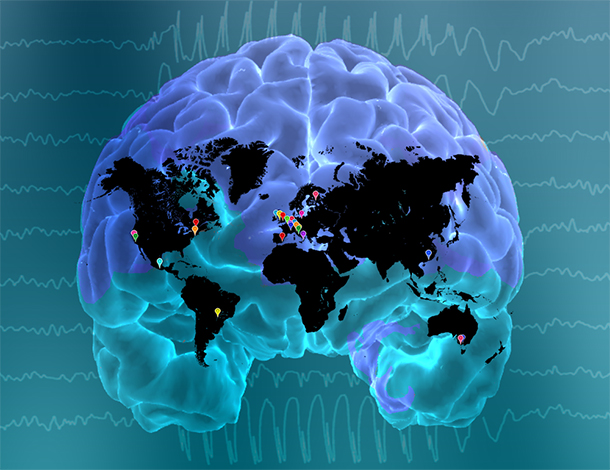Paul Thompson, PhD, associate director of the USC Mark and Mary Stevens Neuroimaging and Informatics Institute (INI) and director of the Imaging Genetics Center (IGC) at the Keck School of Medicine of USC, has already united hundreds of researchers in 39 countries with the Enhancing Neuro Imaging Genetics through Meta-Analysis (ENIGMA) consortium. Through ENIGMA, scientists team up to pool and analyze brain imaging and genetics data — and they’ve published some of the largest imaging studies of schizophrenia, bipolar disorder, obsessive-compulsive disorder, autism, post-traumatic stress disorder and more.

The ENIGMA World Aging Center combines studies of lifespan, plasticity, epigenetics and Parkinson’s to create a comprehensive picture of the aging brain. (Image/Courtesy of Paul Thompson)
But Thompson isn’t stopping there. He and his team just launched the ENIGMA World Aging Center, which will use the consortium’s network and a $682,000 grant from the National Institute on Aging to perform a global study of brain aging. The collaboration will help pinpoint the factors that contribute to healthy aging versus those that increase our risk for Alzheimer’s or Parkinson’s disease.
“The goal of the Center is to bring together experts worldwide to understand what helps us age successfully,” Thompson said. “By analyzing data on brain aging across cultures as diverse as India, the Middle East, Russia and Japan, we are beginning to find sources of risk in our genome and environment — and new ways to reduce that risk.”
Genetics and brain aging
Globally, care and treatment for people with dementia costs more than $604 billion every year. As researchers race to find ways to slow or reverse the progression of diseases like Alzheimer’s, pooling resources and subjects through international collaboration is a key tool for discovery.
“Some of the larger projects screen every letter of our DNA for abnormalities that speed up brain aging, or that increase our risk for Alzheimer’s and Parkinson’s disease,” Thompson said.
“We look at brain scans worldwide to see how genetic variants alter the brain’s wiring and functional synchrony — and what we can do to resist the brain’s decline as we age.”
The World Aging Center comprises four component projects, each a key piece of the brain aging puzzle. ENIGMA Lifespan creates statistical charts of various brain measures at different ages, so researchers can detect abnormalities around the world. ENIGMA Plasticity screens the network’s DNA for “spelling mistakes” or “single-letter” changes that speed up or slow down brain aging.
Meanwhile, ENIGMA Epigenetics studies our “epigenetic clocks” — a measure of biological wear and tear — and relates them to brain aging. ENIGMA Parkinson’s, co-led by the INI’s Neda Jahanshad, PhD, is the largest worldwide imaging study of Parkinson’s disease.
A global effort
Global reach and cooperation are what makes the ENIGMA consortium and its new World Aging Center truly innovative. Working with researchers around the world means incorporating diverse perspectives and data from a variety of populations, which improves researchers’ understanding of how genetics affects the aging process.
“A tremendous lack of ethnic diversity exists in the field of neuroscience,” Thompson said. “We’re working to change that through our international partnerships, which will be central to our understanding of how diverse populations experience aging.”
The INI leads several other global efforts in the neurosciences, including the Global Alzheimer’s Association Interactive Network, a data-sharing platform that allows researchers to explore and analyze data from hundreds of thousands of dementia patients worldwide. The one-of-a-kind federated network aggregates clinical, genetic, imaging and other data to help advance research into the causes and prevention of Alzheimer’s disease.
For more information or to join ENIGMA’s effort, visit the ENIGMA World Aging Center online.
— Zara Greenbaum